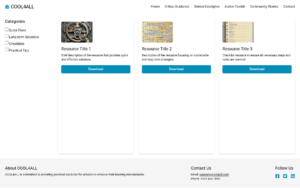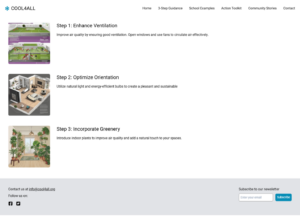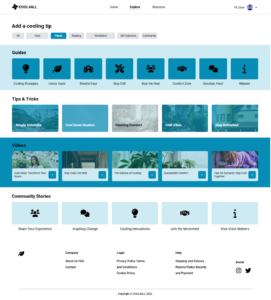COOL4ALL: An Online Platform for Indoor Heat Adaptation
Urban Heat as a Growing Challenge
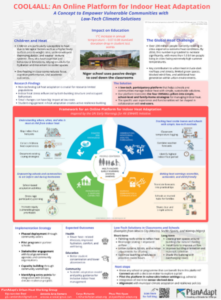
Extreme heat is becoming one of the most urgent urban challenges, disproportionately affecting vulnerable populations with significant social, economic and health implications. Today, over 200 million people live in cities experiencing extreme heat, and by 2050, this number is projected to exceed 1.6 billion (The Future We Don’t Want, C40 Cities, 2018).
The urban heat island (UHI) effect amplifies heat exposure, particularly in densely built areas worsened by dark surfaces, limited green spaces, and restricted airflow. The consequences are not evenly distributed: people living in low-income neighbourhoods and inadequately ventilated buildings experience significantly higher heat stress. Homes and indoor spaces, including school classrooms often retain accumulated heat, leading to sustained indoor discomfort and health risks, particularly for vulnerable groups (Santamouris, 2019; Harlan et al., 2006).
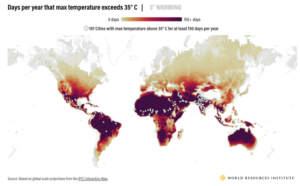
Yet most existing adaptation strategies remain infrastructure-heavy, high-cost and generalised, often overlooking the diverse social and structural realities of urban residents. There is a clear need for solutions that are accessible, low-cost, and tailored to individual living and working environments, that can be implemented directly by those most affected (Eriksen et al., 2021; Anguelovski et al., 2016).
The Overlooked Dimension: Indoor Heat Stress
While urban heat is often discussed in relation to outdoor environments and city infrastructure, indoor spaces, where people spend most of their time living, working, studying, and recovering, are equally vulnerable to rising temperatures (Kenny et al., 2024).
Sustained indoor heat exposure affects health, concentration and productivity. It can be especially harmful to children, the elderly and people with chronic illnesses. Schools, workplaces and healthcare settings frequently experience extreme indoor temperatures, yet these spaces remain underrepresented in adaptation planning (Hampo et al., 2024).
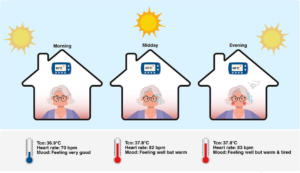
Indoor heat stress is influenced by both building structures and occupant behaviours, such as ventilation, materials, and shading practices. For many resource-limited communities, low-cost and non-technological adaptation measures are crucial and can offer the most immediate protection (Kenny et al., 2024; Song et al., 2021). However, accessible, evidence-based guidance on what these measures are and how to implement them in different contexts remains scarce
Introducing COOL4ALL: A Platform for Contextualised, Low-Tech Adaptation
COOL4ALL is an emerging concept for a low-tech, online platform designed to provide personalized, practical guidance to help individuals adapt their indoor spaces to extreme heat. Inspired by the UN’s Early Warnings for All (EW4All) Initiative, the platform applies the same principle of timely, locally relevant and actionable information – but in the context of adaptation rather than early warning. Its goal is to make indoor heat adaptation both intelligible and achievable, bridging the gap between research evidence and lived experience.
Schools as a Testing Ground
Implementing changes in private properties can be challenging, particularly when there are no clear examples to follow. Schools, however, provide an excellent testing ground for demonstrating practical, scalable solutions. Many school buildings worldwide face extreme heat due to poor ventilation, inadequate shading, and limited cooling systems, creating uncomfortable learning environments that negatively affect student concentration and health (Vasilakopoulou & Santamouris, 2025). They are collective spaces where environmental learning and behavioural experimentation can occur, and where benefits can extend beyond the school into the wider community (Chapagain & Mikkelsen, 2023).
A participatory study in Seville illustrates the potential of low-cost, co-developed solutions to improve thermal comfort, including rearranging seating to improve airflow, using curtains and blinds for shading, and adopting adaptive behaviours such as wearing light clothing and ensuring hydration (Domínguez-Amarillo et al., 2020).
These findings highlight a central principle: effective adaptation emerges through co-learning and participation, not just through technological solutions. By empowering students and teachers to actively participate in modifying their thermal environments, schools can serve as demonstration sites of low-cost, effective adaptation interventions that could be applied to other public or private spaces.
What Would the Online COOL4ALL Platform Look Like?
The envisioned platform is designed to provide personalized guidance based on building and occupant characteristics, integrating both structural and behavioural recommendations. Features may include:
- Tailored, low-tech adaptation strategies for improving indoor thermal comfort;
- Guidance on optimizing ventilation, shading, and room usage;
- Examples of practical solutions from participatory school studies; and
- A collaborative space for teachers, students, and community members to share experiences.
The platform’s logic is grounded in systems thinking – indoor heat risk arises from the interactions between physical environments, human behaviour and institutional arrangements. Addressing it, therefore, requires both technical knowledge and social learning pathways that connect science and lived experience.

